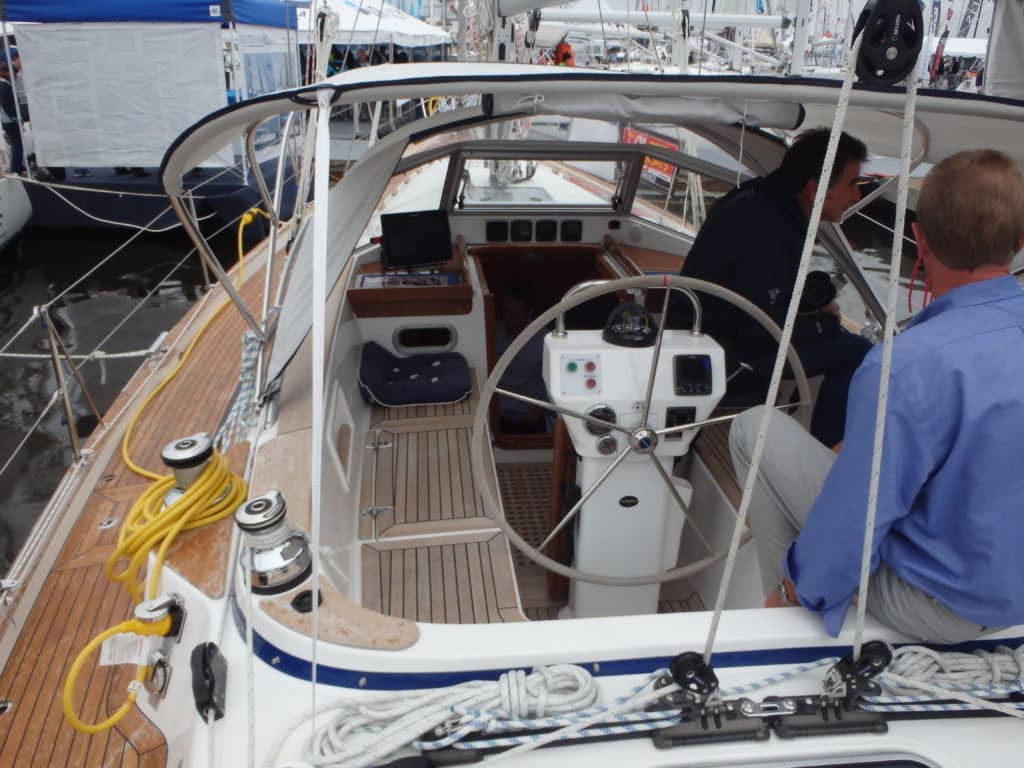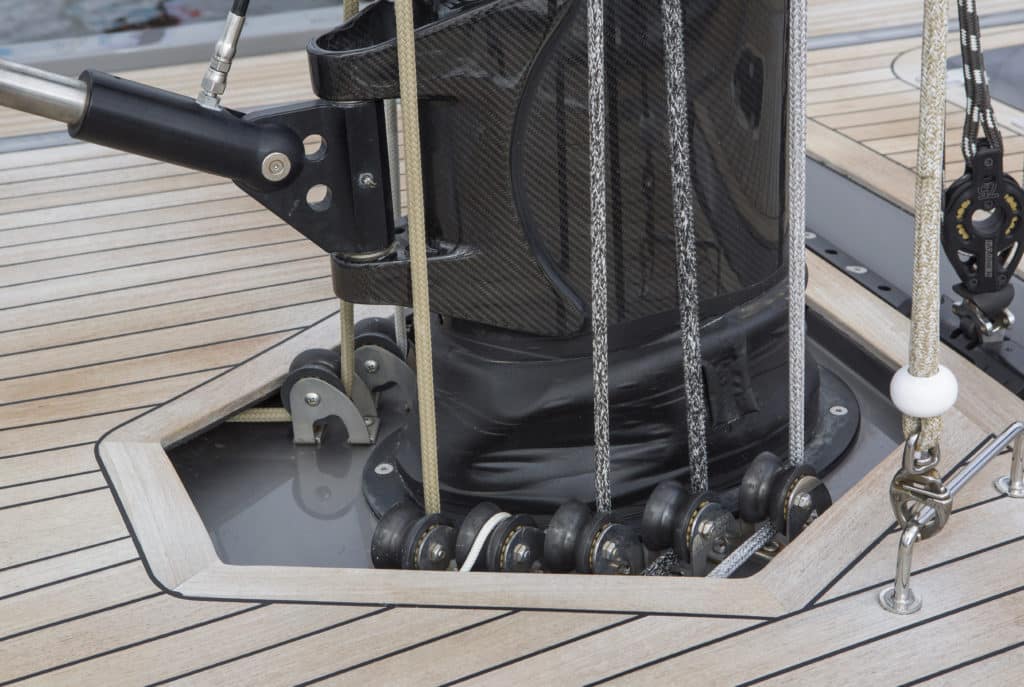
Today’s sailboat design has matured well beyond mere hull forms. Designers are focusing ever more intensely on the parts that make up a boat: underbody, rig, cabins, cockpit and deck layout. It’s on these last two categories that we’ll focus now as we reflect on the monohulls that comprised the 2017 Boat of the Year fleet.
The natural compromises inherent in all cruising boats are on full display when we examine cockpits and decks. Control and comfort are a good starting point for our examination, and a choice that favors one of these traits sometimes comes at the cost of the other.
Control: Shaping the Sails
A glance at the exterior instantly telegraphs signals about a boat’s overall design brief. Start with a simple question: Where does the mainsheet end? Two boats built by the same company — the 34-foot Elan E4 and the 45-foot Elan Impression, each designed by Rob Humphreys — illustrate the point.
The E4 features a double-ended mainsheet at the boom’s aft end with a low-friction traveler in the cockpit sole, just forward of the helm. The Impression, by contrast, features midboom sheeting, no traveler, and just one end of the sheet to work with. In these examples, the E4 offers significantly better control of the mainsail — particularly for shaping the leech — while the Impression trades that sail-handling control for the comfort and convenience of fewer lines to fiddle with, less clutter in the cockpit, and ample space to install a big bimini.
A deeper look at both boats confirms our quick-and-dirty hypothesis. The E4 is a hard-chined, twin-rudder performance cruiser with a keel-stepped mast and a displacement-to-length ratio (D/L) of 150; this is a boat that’s been optimized for speed, if not straight-up racing. The double-ended mainsheet allows crew in racing mode to sheet both ends simultaneously, doubling the speed of maneuvers. The Elan Impression, by contrast, exhibits fuller hull sections, a deck-stepped mast, tankage for 230 gallons of fluids and a D/L of 205; it is, in short, a dedicated cruising boat.
As we look through the 2017 fleet, all the boats in the Performance Cruiser category — the Alerion 30 Sport, Elan E4, J/112 E and Dehler 34 — exhibit end-boom sheeting, as do two other performance-oriented boats from the full-size cruiser categories: the X-Yachts X4 and the Solaris 50. The Dehler and the X4 are standout crossover boats: “cruiser-racers,” to bring back an outdated expression, and winners in their respective categories in our 2017 contest. Another category winner, the Solaris 50, features a mainsheet that terminates at a single point at the centerline of the cockpit sole, relying mainly on the hydraulic vang for leech-shaping. For the J/112 E, naval architect Alan Johnstone designed exemplary ergonomics into the helm station. With a full crew, the helmsperson can stand on centerline aft of the helm, or sit outboard on a coaming with easy fingertip control of the helm. Alternatively, when sailing short-handed, the driver can sit outboard just forward of the helm, with a good footrest on the binnacle and within ideal reach of the mainsheet and low-friction traveler.
The Alerion 30 Sport and the Hallberg-Rassy 40 Mk II put end-boom sheeting to different uses. In these two boats, the mainsheet terminates aft of the helm, outside the coaming, which keeps the cockpit clear of the sheet while still providing optimum sail-shaping control. The Alerion 30 Sport uses its praiseworthy performance not in service of collecting trophies, but rather toward an exquisite daysailing experience for one or two people at a time.
The Hallberg-Rassy is alone among this crowd: classed not as a performance cruiser (its D/L of 227 is the heaviest among the 2017 fleet) but as a center-cockpit, all-oceans cruising boat. Bluewater sailors like to shape their sails too, and this Hallberg-Rassy was among the short list that this year’s BOTY judges would love to take deep-sea voyaging, the sooner the better.
Of the boats with midboom sheeting, the judges preferred those with travelers: the Catalina 42 and the Dufour 460 Grand Large. Offering the least mainsail-shaping control were the Beneteau Oceanis Yacht 62, Elan Impression 45 and the Jeanneau 58. On each of these boats, the mainsheet terminates at twin blocks and provides little to no athwartships control.

Comfort: Hide the Running Gear
In the past few years, we’ve observed two trends related to both the standing and the running rigging.
The first trend is the prevalence of nonoverlapping jibs. This means that designers can bring the shrouds out to the hull instead of to tangs in the middle of the side deck, which typically require tie rods or hanging knees below deck to support the rig’s tension loads. The wider shroud base provides better structure for the rig. This design was adopted by all the performance cruisers we mentioned above, as well as the Dufour 460 Grand Large and the Beneteau Oceanis Yacht 62. For the crew, this arrangement opens a much better passage forward along the side deck; you don’t have to step awkwardly around the shrouds.
The other recent trend is twofold. More than a decade ago, designers began bringing nearly all the running rigging, including halyards, back to the cockpit. Lately, we see many builders covering that running rigging in channels under the cabin top. In this year’s fleet, those boats include the Alerion 30 Sport, Beneteau 62, Dehler 34, Dufour 460 Grand Large, Elan Impression 45, Jeanneau 58, Solaris 50 and X-Yachts X4. The look is elegant, and the technique keeps running line out from under the feet of crew working — or lounging — on deck. That said, we preferred the installations — on the Alerion, Dehler, Jeanneau and Elan Impression — that provided access to gear such as turning blocks that occasionally require service. The X4 provides access from under the deck, and the Dehler has a cover that can be removed with several screws. The Beneteau requires breaking a caulk bond, which would be time consuming to service.
Jumping on and off two dozen boats in a week, we appreciated such builders as Dehler and Dufour, who labeled line stoppers by their function. Catalina designer Gerry Douglas color-codes all the running rigging and organizes it identically throughout the brand’s line so sailors moving through the fleet can recognize sheets, furlers and outhauls in an instant. Still another feature of the Catalina’s deck design that contributed toward its selection as Domestic Boat of the Year was that the builder added raised bosses in the deck tooling around chainplates and stanchion bases to prevent standing water from doing damage down the line.
On the Jeanneau 58 and the X4, the designers made choices that favor low friction of headsail controls (a good thing) but at the cost of foredeck tripping hazards (a less-good thing).
The convenience of having all lines run to the cockpit brings at least one other trade-off. BOTY judge and sailmaker Carol Hasse strongly prefers halyards, especially for cruising chutes, that can be jumped at the mast for quicker setting. For halyards that run internally in the mast, this means they must exit above shoulder height. A line stopper in that position helps too, particularly for short-handed crews.
Tim Murphy is a Cruising World editor-at-large and a longtime Boat of the Year judge.








